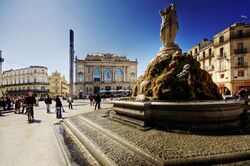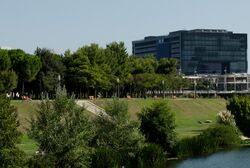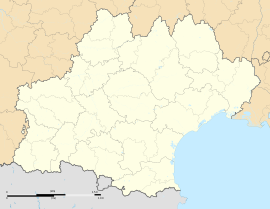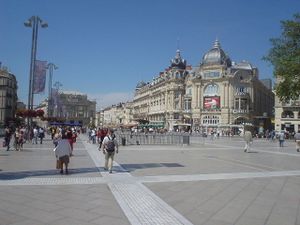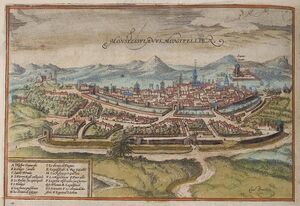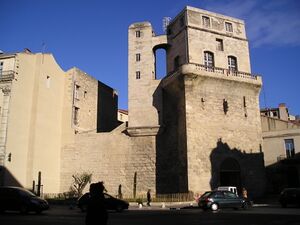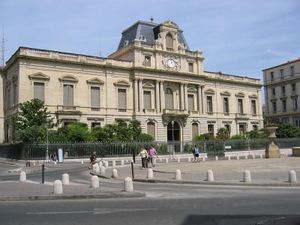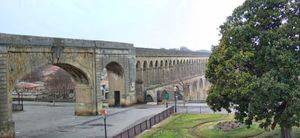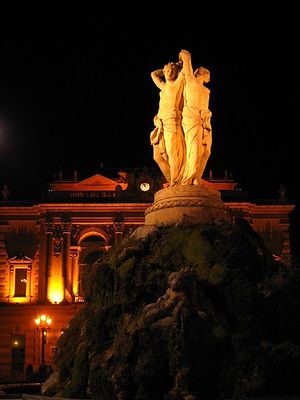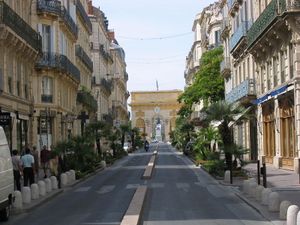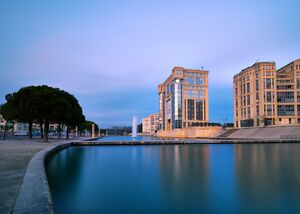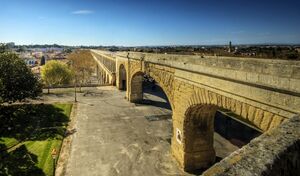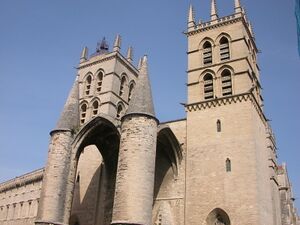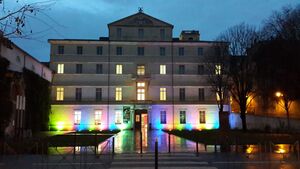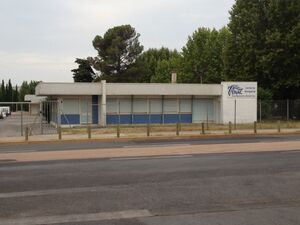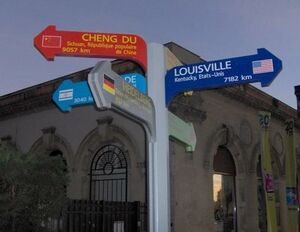مونپلييه
Montpellier
Montpelhièr (أوكسيتان) | |
|---|---|
Prefecture and commune | |
Clockwise from top: The Place de la Comédie, Port Marianne's lake, the bank of the Lez with the Montpellier Town Hall, and the Cathedral of Saint Peter. | |
| الإحداثيات: 43°36′43″N 3°52′38″E / 43.6119°N 3.8772°ECoordinates: 43°36′43″N 3°52′38″E / 43.6119°N 3.8772°E | |
| البلد | فرنسا |
| المنطقة | أوكسيتاني |
| الإقليم | Hérault |
| الدائرة | Montpellier |
| الكانتون | Montpellier-1, 2, 3, 4, 5 and Montpellier – Castelnau-le-Lez |
| بينالتجمعات | Montpellier Méditerranée Métropole |
| الحكومة | |
| • العمدة (2020–2026) | Michaël Delafosse[1] |
| المساحة 1 | 56٫88 كم² (21٫96 ميل²) |
| • الحضر | 310٫0 كم² (119٫7 ميل²) |
| • العمران | 2٬414 كم² (932 ميل²) |
| التعداد (يناير 2019) | 295٬542 |
| • الترتيب | 7th in France |
| • الكثافة | 5٬200/km2 (13٬000/sq mi) |
| • Urban (Jan. 2020[2]) | 465٬950 |
| • الكثافة الحضرية | 1٬500/km2 (3٬900/sq mi) |
| • العمرانية (Jan. 2020[3]) | 813٬272 |
| • الكثافة العمرانية | 340/km2 (870/sq mi) |
| صفة المواطن | Montpelliérain (masculine) Montpelliéraine (feminine) |
| منطقة التوقيت | UTC+01:00 (CET) |
| • الصيف (التوقيت الصيفي) | UTC+02:00 (CEST) |
| INSEE/الرمز البريدي | 34172 /34000, 34070, 34080, 34090 |
| المنسوب | 7–121 m (23–397 ft) (avg. 27 m or 89 ft) |
| 1 French Land Register data, which excludes lakes, ponds, glaciers > 1 km2 (0.386 sq mi or 247 acres) and river estuaries. | |
مونپلييه ( Montpellier ؛ UK /mɒntˈpɛlieɪ/, الأمريكي /ˌmoʊnpɛlˈjeɪ/, بالفرنسية: [mɔ̃pəlje, -pɛl-] (![]() استمع);[4][5] أوكسيتان: Montpelhièr [mumpeˈʎɛ]) هي مدينة فرنسية. تقع في جنوب فرنسا، بالقرب من البحر المتوسط. One of the largest urban centres in the region of Occitania, Montpellier is the prefecture of the department of Hérault. يبلغ عدد سكانها 299,096 نسمة (احصاءات 2020) في المدينة نفسها،[6] while its metropolitan area had a population of 813,272.[3] The inhabitants are called Montpelliérains.
استمع);[4][5] أوكسيتان: Montpelhièr [mumpeˈʎɛ]) هي مدينة فرنسية. تقع في جنوب فرنسا، بالقرب من البحر المتوسط. One of the largest urban centres in the region of Occitania, Montpellier is the prefecture of the department of Hérault. يبلغ عدد سكانها 299,096 نسمة (احصاءات 2020) في المدينة نفسها،[6] while its metropolitan area had a population of 813,272.[3] The inhabitants are called Montpelliérains.
In the Middle Ages, Montpellier was an important city of the Crown of Aragon (and was the birthplace of James I), and then of Majorca, before its sale to France in 1349. Established in 1220, the University of Montpellier is one of the oldest universities in the world and oldest medical school still in operation, with notable alumni such as Petrarch, Nostradamus and François Rabelais. Above the medieval city, the ancient citadel of Montpellier is a stronghold built in the seventeenth century by لويس الثالث عشر من فرنسا.
Since the 1990s, Montpellier has experienced one of the strongest economic and demographic growth in the country.[بحاجة لمصدر] Its urban area has experienced the highest population growth in France since the year 2000. Numbering 70,000, students comprise nearly one-fourth of its population, one of the highest such proportions in Europe.[7] Its living environment with one of Europe's largest pedestrian area,[8] along with its rich cultural life and Mediterranean climate, explain the enthusiasm for the city, which is nicknamed the "Gifted". Montpellier was nominated for "Best Emerging Culture City of the Year 2017" by the think tank LCD.[9] It is ranked as a Sufficiency city by the Globalization and World Cities Research Network.
. . . . . . . . . . . . . . . . . . . . . . . . . . . . . . . . . . . . . . . . . . . . . . . . . . . . . . . . . . . . . . . . . . . . . . . . . . . . . . . . . . . . . . . . . . . . . . . . . . . . . . . . . . . . . . . . . . . . . . . . . . . . . . . . . . . . . . . . . . . . . . . . . . . . . . . . . . . . . . . . . . . . . . . .
الوضع
مونپلييه هي ثالث أكبر مدينة فرنسية بالقرب من ساحل [[البحر المتوسط، بعد مارسيليا ونيس. It is the seventh-largest city of France, and is also the fastest-growing city in the country over the past 25 years.[بحاجة لمصدر]
الجغرافيا
تقع مدينة مونبلييه على أرض مرتفعة عن شاطئ البحر المتوسط بمسافة 10 كيلومتر (6 أميال) ، على نهر ليز. الإسم الأصلي للمدينة هو Monspessulanus والذي حرف إلى mont pelé ويعني التل العاري حيث كانت الأرض الزراعية في تلك المدينة قليلة.
The city is situated on hilly ground 10 km (6 mi) inland from the Mediterranean coast, on the river Lez. The name of the city, which was originally Monspessulanus, is said to have stood for mont pelé (the naked hill, because the vegetation was poor), or le mont de la colline (the mount of the hill).
Montpellier is located 170 km (106 mi) from Marseille, 242 km (150 mi) from Toulouse, and 748 km (465 mi) from Paris.
Montpellier's highest point is the Place du Peyrou, at an altitude of 57 m (187 ft). The city is built on two hills, Montpellier and Montpelliéret, thus some of its streets have great differences of altitude. Some of its streets are also very narrow and old, which gives it a more intimate feel.
التاريخ
العصور الوسطى
In the Early Middle Ages, the nearby episcopal town of Maguelone was the major settlement in the area, but raids by pirates encouraged settlement a little farther inland. In 737 Charles Martel destroyed Maguelonne.[10]
Montpellier, first mentioned in a document of 985, was founded under a local feudal dynasty, the Guilhem, who combined two hamlets and built a castle and walls around the united settlement. The name is from medieval Latin mons pisleri, "Woad Mountain" referring to the woad (Latin pastellus, pestellus) used for dyeing locally. There is no real "mountain" in the area, with the mons referring to a pile of stones.[11] في 986 the Lords of Montpellier begin with William I of Montpellier In the 10th century the town consisted of two portions, Montpellier and Montpelliéret.[10] In 1160 the law school was active.[10] The two surviving towers of the city walls, the Tour des Pins and the Tour de la Babotte, were built later, around the year 1200. Montpellier came to prominence in the 12th century—as a trading centre, with trading links across the Mediterranean world, and a rich Jewish cultural life that flourished within traditions of tolerance of Muslims, Jews and Cathars—and later of its Protestants. William VIII of Montpellier gave freedom for all to teach medicine in Montpellier in 1180. The city's faculties of law and medicine were established in 1220 by Cardinal Conrad of Urach, legate of Pope Honorius III; the medical faculty has, over the centuries, been one of the major centres for the teaching of medicine in Europe. This era marked the high point of Montpellier's prominence. The city became a possession of the Kings of Aragon in 1204 by the marriage of Peter II of Aragon with Marie of Montpellier, who was given the city and its dependencies as part of her dowry.
Montpellier gained a charter in 1204 when Peter and Marie confirmed the city's traditional freedoms and granted the city the right to choose twelve governing consuls annually. Under the Kings of Aragon, Montpellier became a very important city, a major economic centre and the primary centre for the spice trade في مملكة فرنسا. It was the second or third most important city of France at that time, with some 40,000 inhabitants before the Black Death. Montpellier remained a possession of the crown of Aragon until it passed to James III of Majorca, who sold the city to the French king Philip VI in 1349, to raise funds for his ongoing struggle with Peter IV of Aragon.
النهضة
In the 14th century, Pope Urban VIII gave Montpellier a new monastery dedicated to Saint Peter, noteworthy for the very unusual porch of its chapel, supported by two high, somewhat rocket-like towers. With its importance steadily increasing, the city finally gained a bishop, who moved from Maguelone in 1536, and the huge monastery chapel became a cathedral. In 1432, Jacques Cœur established himself in the city and it became an important economic centre, until 1481 when Marseilles overshadowed it in this role.
From the middle of the 14th century until the French Revolution (1789), Montpellier was part of the province of Languedoc.
بعد الإصلاح
At the time of the Reformation in the 16th century, many of the inhabitants of Montpellier became Protestants (or Huguenots as they were known in France) and the city became a stronghold of Protestant resistance to the Catholic French crown. In 1622, King Louis XIII besieged the city which surrendered after a two-month siege (Siege of Montpellier), afterwards building the Citadel of Montpellier to secure it. Louis XIV made Montpellier capital of Bas Languedoc, and the town started to embellish itself, by building the Promenade du Peyrou, the Esplanade and a large number of houses in the historic centre. After the French Revolution, the city became the capital of the much smaller Hérault.
التاريخ الحديث
During the 19th century the city thrived on the wine culture that it was able to produce due to the abundance of sun throughout the year. The wine consumption in France allowed Montpellier's citizens to become very wealthy until in the 1890s the phylloxera induced fungal disease had spread amongst the vineyards and the people were no longer able to grow the grapes needed for wine.[12] After this the city had grown because it welcomed immigrants from Algeria and other parts of northern Africa after Algeria's independence from France. In the 21st century Montpellier is between France's number seventh and eighth largest city. The city had another influx in population more recently, largely due to the student population, who make up about one-third of Montpellier's population. The school of medicine kickstarted the city's thriving university culture,[13] though many other universities have been well established there. The coastal city also benefited in the past 40 years from major construction programs such as Antigone, Port Marianne and Odysseum districts.
. . . . . . . . . . . . . . . . . . . . . . . . . . . . . . . . . . . . . . . . . . . . . . . . . . . . . . . . . . . . . . . . . . . . . . . . . . . . . . . . . . . . . . . . . . . . . . . . . . . . . . . . . . . . . . . . . . . . . . . . . . . . . . . . . . . . . . . . . . . . . . . . . . . . . . . . . . . . . . . . . . . . . . . .
حكام مونبلييه
- وليام الأول (1019)
- وليام الثاني (1025)
- وليام الثالث (1058)
- وليام الرابع (1068)
- وليام الخامس (1120)
- وليام السادس (1149)
- وليام السابع (1179)
- وليام الثامن (1202)
- ماري (1219)
- الملك بيتر الثاني (1213)
- جيمس الأول (1276)
- جيمس الثاني (1311)
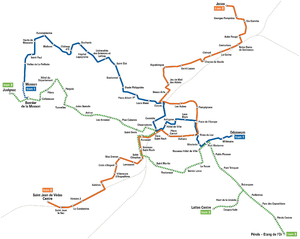
أهم المزارات
- Place de la Comédie
- Musée Fabre.
- فندق مونبلييه.
- الحديثة النباتية أنشئت 1596.
- كاتدرائية سانت بيير ، القرن الرابع عشر.
- Porte du Peyrou (قوس النصر).
- Aqueduc Saint-Clément.
- The Antigone District and other housing projects have been designed by the architect Ricardo Bofill from Catalonia, Spain
- A number of châteaux, so-called follies, built by wealthy merchants surround the city
التعليم
التاريخ
تعتبر جامعة مونبليه من أقدم الجامعات في العالم حيث بنيت عام 1160، and having been granted a charter in 1220 by Cardinal Conrad von Urach and confirmed by Pope Nicholas IV in a papal bull of 1289. It was suppressed during the French Revolution but was re-established in 1896.
It is not known exactly at what date the schools of literature were founded which developed into the Montpellier faculty of arts; it may be that they were a direct continuation of the Gallo-Roman schools. The school of law was founded by Placentinus, a doctor from Bologna University, who came to Montpellier in 1160, taught there during two different periods, and died there in 1192. With regard to the school of medicine, there were excellent physicians at Montpellier. The statutes given in 1220 by Cardinal Conrad, legate of Honorius III, which were completed in 1240 by Pierre de Conques, placed this school under the direction of the Bishop of Maguelonne. Pope Nicholas IV issued a Bull in 1289, combining all the schools into a university, which was placed under the direction of the bishop, but which in fact enjoyed a large measure of autonomy.
Theology was at first taught in the convents, in which St. Anthony of Padua, Raymond Lullus, and the Dominican Bernard de la Treille lectured. Two letters of King John prove that a faculty of theology existed at Montpellier independently of the convents, in January 1350. By a Bull of 17 December 1421, Martin V granted canonical institution to this faculty and united it closely with the faculty of law. In the 16th century the faculty of theology disappeared for a time, when Calvinism, in the reign of Henry II of France, held complete possession of the city. It resumed its functions after Louis XIII had reestablished the royal power at Montpellier in 1622; but the rivalries of Dominicans and Jesuits interfered seriously with the prosperity of the faculty, which disappeared at the Revolution. The faculty numbered among its illustrious pupils of law Petrarch, who spent four years at Montpellier, and among its lecturers Guillaume de Nogaret, chancellor to Philip the Fair, Guillaume de Grimoard, afterwards pope under the name of Urban V, and Pedro de Luna, antipope as Benedict XIII. But after the 15th century this faculty fell into decay, as did also the faculty of arts, although for a time, under Henry IV of France, the latter faculty had among its lecturers Casaubon.
The Montpellier school of medicine owed its success to the ruling of the Guilhems, lords of the town, by which any licensed physician might lecture there; there was no fixed limit to the number of teachers, lectures were multiplied, and there was a great wealth of teaching. Rabelais took his medical degrees at Montpellier. It was in this school that the biological theory of vitalism, elaborated by Barthez (1734–1806), had its origin. The French Revolution did not interrupt the existence of the faculty of medicine.
The faculties of science and of letters were re-established in 1810; that of law in 1880. It was on the occasion of the sixth centenary of the university, celebrated in 1889, that the Government of France announced its intention—which has since been realized—of reorganizing the provincial universities in France.
الجامعات
- University of Montpellier: sciences, medicine, dentistry, pharmacy, law, business, sports
- Paul Valéry University: arts, languages and social sciences
University of Montpellier 1 and University of Montpellier 2 reunified in January 2015 to form the University of Montpellier. Paul Valéry University Montpellier, remains a separate entity.[14]
Moreover, Montpellier was ranked 119th best student city in the world for 2013, according to QS Best Student Cities 2023 ranking.[15]
المدارس العليا
- العلوم
- E-Artsup
- École Polytechnique Universitaire de Montpellier (Polytech)
- National Superior Architecture School of Montpellier (ENSAM)
- École nationale de l'aviation civile
- ENSCM: chemistry
- École pour l'informatique et les nouvelles technologies
- Institut supérieur européen de formation par l'action
- Montpellier SupAgro: agronomy
- SUPINFO International University: private institution of higher education in general Computer Science
- البزنس
- Montpellier Business School
- SupExup Higher Education Institute
النقل
الرياضة
. . . . . . . . . . . . . . . . . . . . . . . . . . . . . . . . . . . . . . . . . . . . . . . . . . . . . . . . . . . . . . . . . . . . . . . . . . . . . . . . . . . . . . . . . . . . . . . . . . . . . . . . . . . . . . . . . . . . . . . . . . . . . . . . . . . . . . . . . . . . . . . . . . . . . . . . . . . . . . . . . . . . . . . .
الثقافة
The city is a centre for cultural events as there are many students. Montpellier has two large concert venues: Le Zenith Sud (7.000 seats) and L'Arena (14.000 seats). Le Corum cultural and conference centre contains three auditoriums.
- The Festival de Radio France et Montpellier is a summer festival of opera and other music held in Montpellier. The festival concentrates on classical music and jazz with about 150 events, including opera, concerts, films, and talks. Most of these events are free and are held in the historic courtyards of the city or in the modern concert halls of Le Corum near historical city center.
- The annual Cinemed, the International Mediterranean Film Festival Montpellier, held in the fall, is the second largest French film festival after the Cannes Film Festival. Held since 1979, it offers screenings of over 200 long and short films, documentaries, animated films, trailers, and a special program of student films.[16] Other events include panel discussions, exhibitions, and gatherings. Venues include Le Corum and cinema halls.
مدن شقيقة
Montpellier is twinned with:[17]
 Barcelona, Spain since 1963
Barcelona, Spain since 1963 Bethlehem, Palestine, since 2012
Bethlehem, Palestine, since 2012 Chengdu, China, since 1981
Chengdu, China, since 1981 Fes, Morocco since 2003
Fes, Morocco since 2003 Heidelberg, Germany, since 1961
Heidelberg, Germany, since 1961 Kos, Greece, since 1962
Kos, Greece, since 1962 Louisville, United States, since 1955
Louisville, United States, since 1955 Obninsk, Russia, since 2017
Obninsk, Russia, since 2017 Palermo, Italy, since 2016
Palermo, Italy, since 2016 Rio de Janeiro, Brazil since 2011
Rio de Janeiro, Brazil since 2011 Sherbrooke, Canada, since 2006
Sherbrooke, Canada, since 2006 Tiberias, Israel, since 1983
Tiberias, Israel, since 1983 Tlemcen, Algeria, since 2009
Tlemcen, Algeria, since 2009
انظر أيضا
المراجع
الهامش
- ^ "Répertoire national des élus: les maires" (in الفرنسية). data.gouv.fr, Plateforme ouverte des données publiques françaises. 13 September 2022.
- ^ INSEE. "Statistiques locales - Montpellier : Unité urbaine 2020 - Population municipale 2020". Retrieved 2023-03-02.
- ^ أ ب INSEE. "Statistiques locales - Montpellier : Aire d'attraction des villes 2020 - Population municipale 2020". Retrieved 2023-03-02.
- ^ "CSA.fr - Êtes-vous [montpeulier], [montpélier] ou encore [montpéyé] ? / Langue française - Prononciation de certains noms de villes / Les dossiers d'actualité / Etudes et publications / Accueil". Archived from the original on 17 April 2017. Retrieved 2 June 2016.
- ^ قالب:Cite LPD
- ^ INSEE. "Statistiques locales - Montpellier : Commune 2022 - Population municipale 2020". Retrieved 2023-03-02.
- ^ "Montpellier Tourist Information and Montpellier Tourism". Montpellier Information and Tourism. Retrieved 5 June 2010.
- ^ "Itinerary of a walk in Montpellier". Travelers without borders (in الإنجليزية الأمريكية). 2015-10-25. Retrieved 2020-10-31.
- ^ "Nomination de Montpellier aux "Leading Culture Destinations Awards 2017"". www.montpellier.fr (in الفرنسية). Retrieved 2020-10-31.
- ^ أ ب ت Britannica 1910.
- ^ Everett-Heath, John (13 September 2018). The Concise Dictionary of World Place-Names. Oxford University Press. ISBN 9780192562432 – via Google Books.
- ^ "Montpellier History Facts and Timeline: Montpellier, Languedoc-Roussillon, France". world-guides.com. Retrieved 5 October 2018.
- ^ Hoad, Phil (13 March 2017). "Montpellier in the spotlight: development mania in France's fastest-growing city". The Guardian. Retrieved 5 October 2018.
- ^ Cougnenc, Rémy. "L'université de Montpellier à l'épreuve de la fusion – Journal La Marseillaise". Lamarseillaise.fr. Archived from the original on 17 August 2017. Retrieved 7 September 2018.
- ^ "QS Best Student Cities 2023". topuniversities.com. Retrieved 19 August 2022.
- ^ "Cinemed: Montpellier International Festival of Mediterranean Film – Montpellier Tourist Office". Montpellier-france.com. Retrieved 7 September 2018.
- ^ "Jumelages". montpellier.fr (in الفرنسية). Montpellier. Retrieved 2019-11-15.
وصلات خارجية
- CS1 الفرنسية-language sources (fr)
- CS1 الإنجليزية الأمريكية-language sources (en-us)
- Short description is different from Wikidata
- Articles containing أوكسيتان (بعد 1500)-language text
- Coordinates on Wikidata
- صفحات تستخدم جدول مستوطنة بقائمة محتملة لصفات المواطن
- Pages using infobox settlement with image map1 but not image map
- Articles with unsourced statements from November 2022
- Montpellier
- Communes of Hérault
- Cities in Occitania (administrative region)
- Prefectures in France
- Crown of Aragon
- Languedoc
- Cities in France
- مدن فرنسا
- صفحات مع الخرائط

